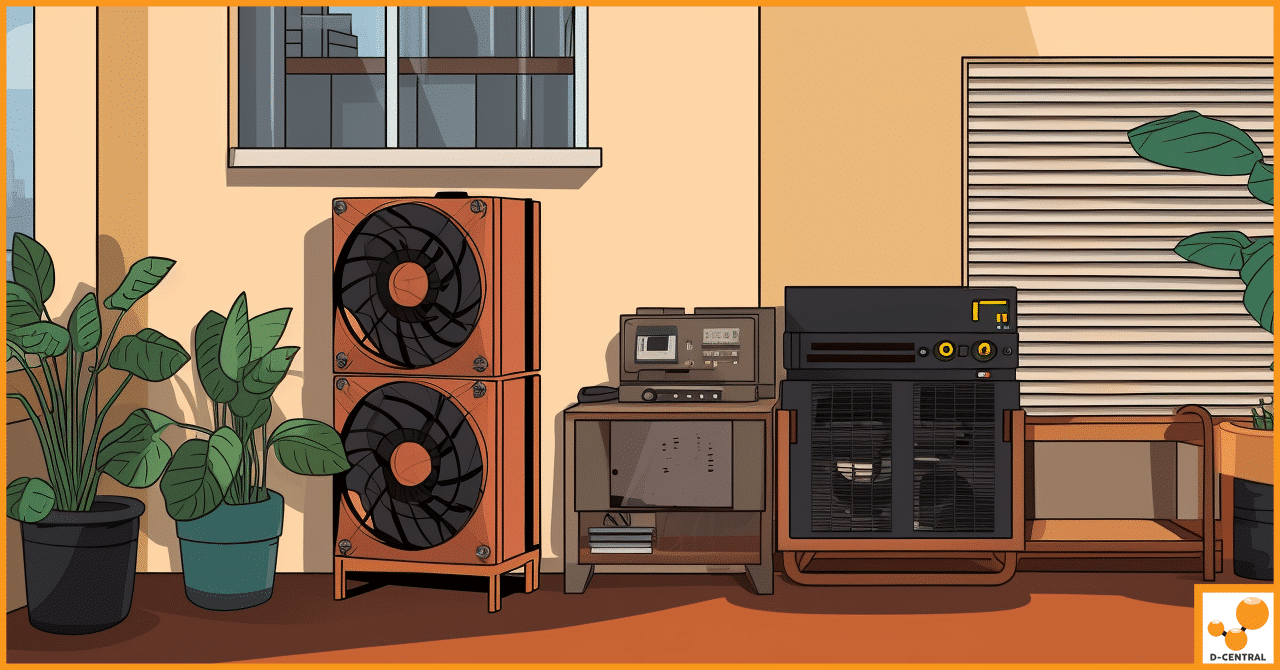
Star Wars, A Bitcoin Story – Episode II: Galactic Credits, Aurodium, and the Bitcoin Standard
As we continue to explore the intricate relationship between the Star Wars universe and the world of cryptocurrency, we delve
4479 Desserte Nord Autoroute 440, Laval, QC H7P 6E2

Bitcoin mining is a crucial component of the Bitcoin network’s function and sustainability. It refers to the process of verifying and adding new transactions to the Bitcoin’s blockchain, ensuring its continuity, accuracy, and security. It involves solving complex mathematical problems, and miners use powerful hardware to perform these computations. For their effort, miners are rewarded with newly minted Bitcoins, providing a significant incentive for the mining process.
But why is Bitcoin mining so important? In addition to the reward incentive, miners also help maintain the network’s decentralization, a key factor in Bitcoin’s value and appeal. By having many miners participating in the network, the power is distributed among them, making it difficult for any single entity to control or manipulate the network. Furthermore, Bitcoin mining helps in maintaining the scarcity of Bitcoin, keeping it valuable in the long term.
Bitcoin mining isn’t without its challenges, one of which is the considerable noise generated by the mining rigs. The devices used for Bitcoin mining, especially the ASIC (Application-Specific Integrated Circuit) miners, are known to produce significant levels of noise due to their high-speed fans and cooling systems. Compared to GPU mining, ASIC miners are more efficient but tend to generate more noise, making noise management even more important. These fans work overtime to keep the hardware from overheating, given the intense processing power required for mining. ASIC mining rigs typically generate noise levels between 50 to 75 decibels, comparable to office noise or a vacuum cleaner.
The continuous noise produced by mining rigs can be disruptive, leading to discomfort for miners, particularly those operating out of home setups. Excessive noise from mining setups can negatively impact community relations and disturb neighbors, sometimes even leading to complaints or conflicts. It can also cause issues with neighbors or violate local noise regulations. This is where the need for soundproofing comes in. Soundproofing can help reduce the noise levels of mining rigs, making the mining environment more peaceful and compliant with local regulations. Integrating sound barriers, such as mass-loaded vinyl or soundproof drywall, into your mining setup is an effective way to contain noise and prevent it from escaping into surrounding areas. It is a critical aspect of managing a home-based mining setup, and there are several methods and materials available for effective soundproofing. Optimizing mining setups for noise reduction not only improves comfort but also helps maintain good relations with neighbors and the community.
Mining rigs consist of various components, each contributing to the overall noise levels. Firstly, the ASIC miners themselves are known to be loud due to the high-intensity computations they perform, resulting in a significant amount of heat that needs to be dissipated. This significant heat generated by the hardware requires robust cooling solutions, such as high-speed fans and ventilation systems, which can further increase noise levels. To counter this, mining rigs have high-speed fans that work constantly to cool down the miners. These fans, due to their high rotations per minute (RPM), generate substantial noise.
Additionally, the cooling systems in place, including the heat sinks and additional external fans, also contribute to the noise. In larger setups, cooling becomes even more challenging, often requiring industrial-grade fans or liquid cooling systems that are inherently noisy. These large-scale operations can produce industrial noise, which has a significant impact on the surrounding environment and may require specialized noise barrier solutions. Power supply units (PSUs) and hard drives, while quieter compared to ASIC miners and fans, still add to the overall noise levels.
The constant noise produced by mining rigs can have several negative impacts. For the miners themselves, long-term exposure to high noise levels can lead to health issues such as hearing loss or increased stress levels. Protecting hearing health is essential due to the high noise levels generated by ASIC miners. The noise can also disrupt day-to-day activities and make the mining environment uncomfortable.
The noise pollution also extends beyond the immediate mining setup. In residential areas, loud mining operations can disturb neighbors, especially in multi-dwelling units where walls and floors might not be sufficiently soundproofed. Furthermore, the noise can potentially disrupt local wildlife in rural or semi-rural locations, leading to ecological concerns.
Given the disruptive potential of mining rig noise, many local jurisdictions have regulations in place to control noise pollution. These regulations may define permissible noise levels during different times of the day, particularly during nighttime hours when people are typically sleeping. Non-compliance with these regulations can lead to fines or other penalties. For home-based miners, this necessitates effective soundproofing measures to ensure their mining operations do not violate local noise regulations. For larger mining facilities, specialized noise control solutions are often required to address the unique challenges posed by electronic and industrial noise. It also highlights the importance of researching and understanding local noise regulations before setting up a mining operation.
Soundproofing your mining rig can lead to a myriad of benefits, improving both your mining experience and the environment. The most immediate advantage is sound reduction, resulting in lower noise levels and creating a more peaceful atmosphere for miners and those nearby. This can significantly improve comfort, especially for home-based miners, and decrease the chances of disturbing neighbors or violating local noise regulations.
Moreover, soundproofing measures can reduce vibrations caused by mining equipment, which can indirectly lower noise levels and increase the stability of your setup. With the right soundproofing methods, miners can run their operations more quietly without sacrificing the efficiency and productivity of their mining rigs.
While soundproofing is crucial, it’s equally essential to ensure proper ventilation in your mining setup. The heat generated by mining rigs due to their high-power computations can significantly impact noise levels, as more cooling is required to manage this heat. Without adequate cooling and ventilation, they risk overheating, which can lead to hardware failure or decreased efficiency. A liquid cooling system, which uses water or oil as a heat transfer medium, can significantly reduce the noise produced by high-speed fans in ASIC miners while efficiently managing the heat generated. This method offers advantages in both noise and heat management, though it may require more complex maintenance compared to traditional air cooling.
When soundproofing, one must not compromise on the rig’s ventilation. Enclosing your mining rig for soundproofing should be done in a way that allows heat to escape and cool air to enter. Therefore, it’s important to strike a balance between noise reduction and adequate cooling to maintain the operational integrity of the mining rig.
Soundproofing your mining rig can also enhance the lifespan of your mining equipment. By reducing noise and vibration, you are mitigating the wear and tear on your hardware. Furthermore, if soundproofing is done with proper attention to ventilation, it can help maintain optimal operating temperatures, which is critical for the longevity of electronic components.
High temperatures can degrade the performance of your mining rig over time and may lead to premature hardware failure. Hence, a well-ventilated and soundproofed mining setup can ensure that your mining rig operates effectively for longer periods, providing better returns on your investment.
Antminer shrouds are specialized components designed to effectively reduce the noise generated by Bitcoin mining rigs. They are essentially a type of cover or enclosure made from sound-absorbing materials and are custom-built to fit over the mining rig. Their primary function is to absorb and dissipate the noise generated by the equipment, thus significantly lowering the overall sound levels. In addition to shrouds, using a mining box as an enclosure can further enhance noise reduction and fire safety for mining operations.
When selecting sound-absorbing materials for these enclosures, options like mega zorbe foam are highly effective, providing an additional noise reduction of around 7 dB and offering fire-rated safety. For those seeking advanced noise control, upstream data’s black box is a notable solution, capable of reducing noise levels by up to 20 decibels and often compared with other noise reduction devices in industrial settings.
Moreover, Antminer shrouds are typically designed to allow for sufficient ventilation, ensuring that the mining rig does not overheat. This two-fold function of noise reduction and heat dissipation makes Antminer shrouds a popular choice among miners looking to soundproof their mining rigs while maintaining optimal performance.
The installation process of Antminer shrouds is fairly straightforward, making it a DIY-friendly soundproofing solution. Here’s a simple guide on how to install them:
Proper maintenance of your Antminer shrouds is essential to ensure they continue to function effectively over time. Here are a few maintenance tips:
In conclusion, Antminer shrouds are an economical and effective way to soundproof your mining rig. They are easy to install, require minimal maintenance, and offer significant noise reduction without compromising on the rig’s performance or lifespan.
When soundproofing your mining rig, one of the critical considerations should be heat dissipation and ventilation. Bitcoin mining equipment generates significant amounts of heat during operation. This heat, if not properly managed, can harm the mining hardware, leading to decreased performance and potential hardware failure.
Soundproofing materials often insulate heat, which can lead to overheating issues if not properly managed. Therefore, the soundproofing solution you choose should accommodate enough ventilation for heat dissipation. When soundproofing, it is crucial to strike a balance between noise reduction and the need for cooling and air circulation.
The size of your mining rig will also affect the soundproofing strategies you can use. Smaller rigs can be accommodated in soundproof boxes or use compact solutions like Antminer shrouds. Soundproof boxes can reduce noise generated by mining rigs by more than 20 decibels. Larger, more powerful rigs, on the other hand, may require industrial-grade soundproofing solutions and more significant ventilation systems.
When planning your soundproofing project, consider the space your mining rig occupies, and choose a solution that can adequately accommodate it while still providing effective noise reduction and heat dissipation.
The cost and feasibility of different soundproofing options should also be taken into account. While some solutions may offer excellent soundproofing, they may be beyond your budget or impractical for your specific setup.
For example, Antminer shrouds are a cost-effective and practical solution for many miners. However, if your mining rig is custom-built or unusually large, it might require a more customised and potentially expensive solution.
Consider your budget, the physical layout of your mining area, and the specific needs of your mining rig when evaluating different soundproofing options. Remember, the best solution will effectively reduce noise without negatively impacting your rig’s performance or breaking the bank.
In conclusion, soundproofing your mining rig is not a luxury but a necessity. As the cryptocurrency mining world becomes more competitive, ensuring a quiet and efficient mining environment can provide you with the peace you need to focus on other important aspects of your operation. Moreover, soundproofing not only benefits you but also the people around you, making it a good neighbor policy as well.
There’s no one-size-fits-all solution when it comes to soundproofing a mining rig. Noise levels, ventilation needs, rig size, and budget vary for each miner. Therefore, soundproofing techniques need to be customized to individual needs. Effective noise reduction strategies include using sound-absorbing materials and selecting quieter cooling fans. Antminer shrouds, acoustic panels, foam underlayments, and insulation foams each have their unique strengths and weaknesses. It’s crucial to consider all these factors before deciding on the best solution.
Finally, achieving optimal soundproofing for your mining rig requires ongoing research and experimentation. As technology advances, newer and better soundproofing materials and techniques are being developed. It’s crucial to stay informed about these developments and to be willing to update your soundproofing strategy as necessary.
Remember, your aim is to create an efficient and quiet mining environment that fosters productivity and well-being. With the right research, planning, and execution, you can achieve this goal.
When it comes to noise reduction in mining operations, safety should never be overlooked. Fire rated materials play a crucial role in protecting your mining setup from the risks associated with excessive heat and electrical components. These specialized materials are engineered to resist the spread of fire, providing an added layer of security for your mining equipment and environment.
Incorporating fire rated materials into your soundproofing solutions—such as mining boxes, enclosures, or custom-built housings—ensures that your noise reduction efforts do not compromise safety. For example, using fire rated panels or insulation within your soundproofing materials can help contain any potential fire, minimizing damage and giving you valuable time to respond in an emergency.
Regular maintenance and inspection of these fire rated materials are essential to maintain their effectiveness. Over time, wear and tear or dust accumulation can reduce their protective qualities, so it’s important to check them periodically as part of your overall mining maintenance routine.
By combining fire rated materials with other noise reduction solutions, such as acoustic panels or liquid cooling systems, you can create a mining environment that is not only quieter but also significantly safer. This comprehensive approach helps protect your investment, your equipment, and your peace of mind, making fire safety an integral part of any modern crypto mining operation.
For home miners looking to reduce mining noise without breaking the bank, DIY soundproofing solutions offer a practical and cost-effective approach. By using various materials designed to absorb and dampen sound waves, you can significantly reduce the noise generated by your mining rigs and create a quieter environment for yourself and your family members.
One popular method is to wrap your mining rig or mining equipment in mass loaded vinyl, a dense material that effectively absorbs sound waves and helps reduce noise levels. Acoustic foam panels are another excellent option; when installed on walls or around your mining facility, they help dampen sound and minimize noise pollution. Soundproofing blankets can also be draped over or around mining rigs to further reduce noise generated during operation.
These DIY solutions are not only effective at reducing noise levels, but they also help minimize complaints from neighbors and family members, making your mining experience more comfortable and sustainable. By experimenting with different materials and setups, home miners can tailor their noise reduction strategies to fit their specific needs and environments.
Ultimately, DIY soundproofing empowers miners to take control of their mining noise, reduce noise pollution, and maintain a more peaceful atmosphere—without the need for expensive or complex installations.
Cooling fans are essential for preventing overheating in mining equipment, but they are also a major source of noise in mining operations. The high speed fans commonly used in mining rigs can generate significant noise levels, impacting both the mining environment and those nearby. Fortunately, there are several strategies miners can use to reduce the noise generated by cooling fans and create a quieter environment.
One effective approach is to switch to slower-speed fans, which can provide adequate cooling for your mining system while producing less noise. Another solution is to install noise dampening enclosures or fan silencers, which absorb sound waves and help reduce the noise level from cooling fans. For those seeking even greater noise reduction, liquid cooling systems offer a quieter alternative to traditional air cooling, as they eliminate the need for high speed fans altogether.
Regular maintenance of your cooling fans is also crucial for noise control. Cleaning dust from fan blades and replacing filters can improve airflow and reduce additional noise caused by obstructions or worn-out components. By keeping your cooling system in top condition, you not only reduce noise levels but also enhance the overall performance and longevity of your mining equipment.
By implementing these noise reduction strategies, miners can maintain efficient cooling, prevent overheating, and enjoy a significantly quieter mining environment—making mining operations more comfortable and sustainable for everyone involved.
Why is it important to soundproof your mining rig?
Soundproofing your mining rig is important because it helps reduce noise pollution, which can be disruptive and even damaging to your hearing over time. It also increases the lifespan of your mining equipment by maintaining a cooler and more stable operating environment.
What is an Antminer shroud and how does it help in soundproofing?
An Antminer shroud is a device designed to enclose an Antminer (a popular Bitcoin mining hardware), helping to reduce the noise it generates. By enclosing the device, the shroud can reduce noise levels by up to 50%.
What factors should I consider when soundproofing my mining rig?
When soundproofing your mining rig, you should consider factors such as the need for heat dissipation and ventilation, the size of your mining rig, and the cost and feasibility of different soundproofing options. Each situation is unique, so it’s important to assess these factors based on your specific needs.
How do I install an Antminer shroud?
Installing an Antminer shroud involves purchasing the right size for your mining rig, attaching it according to the included instructions, and powering up your rig to experience reduced noise levels. Remember to regularly maintain the shroud by cleaning any dust buildup.
DISCLAIMER: D-Central Technologies and its associated content, including this blog, do not serve as financial advisors or official investment advisors. The insights and opinions shared here or by any guests featured in our content are provided purely for informational and educational purposes. Such communications should not be interpreted as financial, investment, legal, tax, or any form of specific advice. We are committed to advancing the knowledge and understanding of Bitcoin and its potential impact on society. However, we urge our community to proceed with caution and informed judgment in all related endeavors.
Related Posts

As we continue to explore the intricate relationship between the Star Wars universe and the world of cryptocurrency, we delve

In the dynamic landscape of the Bitcoin ecosystem, Marathon Digital Holdings has introduced a pioneering service known as Slipstream. This

Bitcoin mining is an exhilarating ride into the heart of the cryptocurrency world. Fondly familiar to some, a mystery to